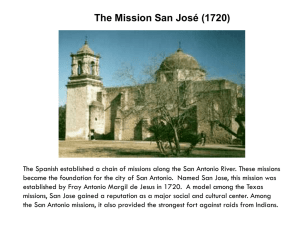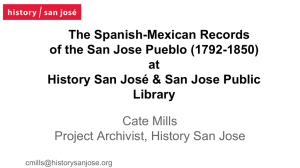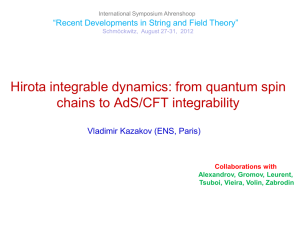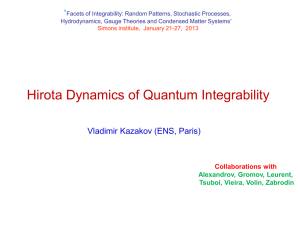PPT
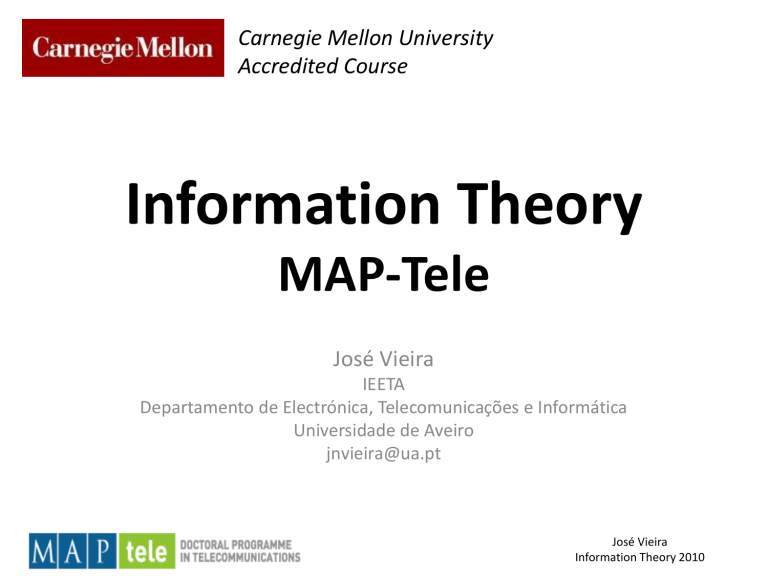
Carnegie Mellon University
Accredited Course
Information Theory
MAP-Tele
José Vieira
IEETA
Departamento de Electrónica, Telecomunicações e Informática
Universidade de Aveiro jnvieira@ua.pt
José Vieira
Information Theory 2010
Carnegie Mellon University
Accredited Course
Part III
Advanced Coding
Techniques
José Vieira
IEETA
Departamento de Electrónica, Telecomunicações e Informática
Universidade de Aveiro jnvieira@ua.pt
José Vieira
Information Theory 2010
Objectives
• To introduce the concept of rateless codes for erasure channels and the concept of digital fountains
• To give an introduction to the first rateless codes and their design
• Illustrative applications
– Network coding
– Distributed storage
José Vieira
Information Theory 2010
Part III – Outline
• The Binary Erasure Channel (BEC)
• Codes for the BEC
• Fountain codes
– Rateless codes
– The LT code
– Design a rateless code
– The rank of random binary matrices
• Applications of Fountain codes
– Network coding
– Distributed storage
José Vieira
Information Theory 2010
The Binary Erasure Channel
• Introduced by Elias in 1955 and regarded as a theoretical model
• Internet changed this notion 40 years later
• On the internet, due to router congestion and
CRC errors, sent packets may not reach the destination
• This packet losses can be regarded as erasures
José Vieira
Information Theory 2010
0
1
The Binary Erasure Channel
1-a a a
1-a
0 e
1
•
• e – erasure a
– erasure probability
• Erasure channel
Capacity: C = 1a
• Intuitive interpretation: since a proportion a of the bits are lost in the channel, we can recover
(at most) a proportion
(1a
) of the bits.
José Vieira
Information Theory 2010
Classical solutions
• When a packet did not reach the destination the receiver sends back a requests for retransmission
• Alternatively, the receiver can send back acknowledgement messages for each successfully received packet. The sender keeps track of the missing packets and retransmits them until all have been acknowledged
José Vieira
Information Theory 2010
Classical solutions
• Both solutions guarantees the correct delivery of all the packets regardless of the rate of packet losses
• However, if the rate of packet losses is high, both of these schemes are very inefficient
• The full capacity of the channel is not reached
• According to Shannon theory, the feedback channel is not necessary
José Vieira
Information Theory 2010
Broadcast channel with erasures
• On a broadcast channel with erasures, the repetition schemes are very inefficient, and can lead to network congestion
• An appropriate Forward Error Correction (FEC) Code should achieve the theoretic channel capacity without feedback channel
• With classical codes the design of the fixed rate
R=K/N , should be performed to worst case conditions
• This restriction makes this coding inefficient also
José Vieira
Information Theory 2010
Reed-Solomon codes for broadcast channels with erasures
• An ( N , K ) Reed-Solomon code correctly decode the K symbols of the message from K codeword symbols
• However, Reed-Solomon codes are only pratical for small values of N and K
• The coding / decoding cost is of order
K ( N
-
K ) log
2
N
José Vieira
Information Theory 2010
Variable rate codes
• If the error probability of a BEC varies, the ideal code should allow on the fly variable encoding rate R=K/N
• With Reed-Solomon codes it is not possible to change R on the fly
• Michael Luby (2002) invented a rateless code with this propriety
José Vieira
Information Theory 2010
Fountain Codes
• This code can generate a potentially infinite number of codewords
• Fountain codes are near optimal for every erasure channel, despite the probability of erasure a
• The message m with K symbols can be decoded from K
´ received codewords, with
K
´ a little larger than K
José Vieira
Information Theory 2010
Fountain Codes
• Consider a message m with K symbols m
m , m , , m
1 2 K
• To generate the n th codeword symbol the encoder chooses the number d of symbols to combine from a degree distribution r
• Then the encoder chooses d symbols at random from m and perform the xor sum
K c n
k
1 m k
G nk
José Vieira
Information Theory 2010
Fountain Codes
• The growing encoding matrix G is formed on the fly, a row at a time
• The rows of G should be transmitted to the receiver as side information
• It is possible to use a seed for a random number generator to generate the same encoding rows of G at the receiver
José Vieira
Information Theory 2010
Fountain Codes
9
10
11
12
6
7
8
1
4
5
2
3
16
17
18
13
14
15
1
1
1 1
1
1
K
1
1 1 1
1
1
1
1
1
1
1
1
1
1
1
1 1
1
1
1
1
1
1 1
1
1
1
1
1
1
1 1
1 1
1
1
1 1 1
1
1
1
1
1
1
1
1
1
1
G
10
11
15
16
1
7
8
3
6
1
1
1
1 1
1
1
1
1
1
1 1
1
1
1 1
K
1 1
1
1
1 1
1
1
1
1 1
1 1
1
1
1
1
N
G ( J )
The transmitted G and the received G ( J ) generator matrix with
J ={1,3,6,7,8,10,11,15,16}
José Vieira
Information Theory 2010
Fountain Codes
• If N<K the decoder does not have enough codeword symbols to recover the original information
• If N≥K and G has an K
K submatrix with inverse, then the receiver can recover the original information. It is possible to use
Gaussian elimination and recover the message m k
n
1 c n
-
1
G kn
José Vieira
Information Theory 2010
Fountain Codes
• If it is possible to find an invertible K
K submatrix in the received N
K matrix, then the solution is unique
• As the matrix is generated at random and we can not predict the columns that we are going to received, the question is:
What is the probability of a K
K random binary matrix being invertible?
José Vieira
Information Theory 2010
Random matrices
• Linear independency
• A set of K vectors v n in some vector space of dim K is linearly independent if
K only with all the a n
1 n
=0 a n v n
0
José Vieira
Information Theory 2010
Probability of a K × K random binary matrix
G
being invertible
• If we have only one vector the probability of being linear independent is the probability of being different from zero
1
-
2
-
K
• With two vectors we have the probability of the second vector being different from zero and different from the first one
• For K
-
2
-
( K
-
1 )
independent
1
-
2
-
K
1
-
2
-
( K
-
1 )
1
1
8
1
1
4
1
1
2
0 .
289
José Vieira
Information Theory 2010
Probability of a random binary matrix
G
being invertible
• If the number N of vectors is greater than K , with E=N-K (excess), what is the probability
(1d
) that there is an invertible K
K submatrix in G?
d
( E )
2
-
E
• Where d is probability of failure and E is the number of redundant packets
José Vieira
Information Theory 2010
Probability of a random binary matrix
G
being invertible
• The number of packets N=K+E in order to have (on average) a guarantee of decoding of
(1d
) is
K
log
2
1 / d
• So, an excess of E packets increases the probability of success to at least
1
d
1
-
2
-
E
José Vieira
Information Theory 2010
Computational cost
• The encoding cost is K /2 symbol operations by codeword
• The decoding cost has two components
– The matrix inversion with K 3 operations by Gaussian elimination
– The application of matrix inverse to the received symbols which costs K 2 /2
• When the value of K increases, random linear fountain codes approximate to the Shannon limit
• Problem to solve: find a coding and decoding technique with lower cost, preferably linear
José Vieira
Information Theory 2010
Sparse random matrices
• The coding and decoding computational cost can be reduced if the coding matrix G is sparse
• Even for matrices with a small average number of ones per row is possible to find an invertible coding matrix
José Vieira
Information Theory 2010
Balls and Bins
• Suppose that we throw N balls to K bins at random
• Question: After throwing N=K balls what fraction of the bins is empty?
• Answer: The probability that a ball hits one of the K bins is 1/ K . The complement is (1-1/ K ) , and the probability that a bin is empty after N balls is
N
1
1
e
-
N / K
K
• For N = K the probability of a certain bin is empty is
1/ e and the fraction of empty bins would be 1/ e also
José Vieira
Information Theory 2010
Balls and Bins
• After throwing N balls the expected number of empty bins is
Ke
-
N / K
• This expected number d of empty bins is small for large N . So we can say that the probability of all bins have a ball is given by (1d
) only if
N
K log e
K d
José Vieira
Information Theory 2010
The LT code
Encoder
• Consider a message m with K elements m
m
1
, m
2
, m
3
, , m
K
1. Choose at random the degree d n degree distribution r
( d ) .
of the codeword from a
2. Choose at random and uniformly, d n distinct input symbols and sum them using the XOR operation.
• This encoding defines a sparse and irregular encoding matrix
José Vieira
Information Theory 2010
The LT code
Decoder
• The decoder must recover m form c = Gm supposing G known
• If some of the codeword symbols are equal to one of the message symbols, then it is possible to decode by the following algorithm
1.
Find a codeword c n with degree one. If it is not possible to find one halt and report fail
2.
Set m i
= c n
3.
Add m i m i
(with XOR) to all codewords c n
4.
Remove all the edges connected to m i that are connected to
5.
Repeat 1 to 4 until all m i are decoded
José Vieira
Information Theory 2010
Decoding example – 1
1 c
0
0 c
1
1 c
2
0 c
3
c c c
2 c
0
1
3
1
1
1
1
0
1
0
1
0
0
1
1
m
0 m m
2
1
m
0
1 m
1 m
2
José Vieira
Information Theory 2010
Decoding example – 2
1 c
0
1 c
1
0 c
2
1 c
3 m
0
1 m
1
1 m
2
José Vieira
Information Theory 2010
Decoding example – 3
1 c
0
1 c
1
0 c
2
0 c
3 m
0
1 m
1
1 m
2
0
José Vieira
Information Theory 2010
Decoding example – 4
1 c
0
0 c
1
0 c
2
0 c
3 m
0
1 m
1
1 m
2
0
José Vieira
Information Theory 2010
The Degree Distribution
• Each codeword is a linear combination of d symbols from the message m
• The degree d is chosen at random from a degree distribution r
( d )
• There are two design conflicts:
– The degree of some codewords should be high to guarantee that all the message symbols are covered
– The degree of some codewords should be low in order to start the decoding process and keep going
José Vieira
Information Theory 2010
Soliton distribution
• Can we design a degree distribution that guarantees the optimal Shannon limit of decoding the K symbols of the message after
K received codewords?
• We want a distribution that on average guarantees that just one message symbol is uncovered at each iteration
• Such a distribution is the Soliton
José Vieira
Information Theory 2010
Soliton distribution
• Step 0
– The expected number of codeword symbols of degree one at step zero should be 1
• Step 1
– One of the message symbols is decoded and it lower the degree of some of the codeword symbols.
– At the end of step 1, at most one degree 2 codeword should be connected to the decoded message symbol in order to decrease its degree to one and the process continues
• Step n
– Continue the process checking at each step that one of the codeword symbols has degree one
José Vieira
Information Theory 2010
r
1
Soliton distribution
1 / K r d
d ( d
1
-
1 ) for d
2 , 3 , , K r d
1
K
,
1
2
,
1
6
1
,
12
, ,
1
K ( K
-
1 )
The mean degree of this distribution is r d
K
1 d r d
d
K
1 d
1
-
1
log e
K
José Vieira
Information Theory 2010
Soliton distribution
c
0 c
1 c
2 c
K codewords m
0 m
1 m
2
With the Soliton distribution the expected number of edges from each message symbol will be log e
K m
K
Message symbols
José Vieira
Information Theory 2010
Soliton distribution
c
0 c
1 c
2 c
K codewords m
0 m
1 m
2
The decoding of m
0 from c
0 causes the degree of the connected codewords to decrease by 1 m
K
Message symbols
José Vieira
Information Theory 2010
Soliton distribution
• Let h t
( d ) be the expected number of codewords of degree d after the d t
• codeword had an edge to
Step 0 th iteration of the algorithm
Expected number of codewords with degree d +1 that reduced their degree h
0
Expected number of h
(
( 1 d
)
)
d
K
K
• Step 1 r r
1 h
1
( 1 )
h
0
( d
2 )
2
K
K
1
K
K r
1
2
2
K
K
1
2
2
K
after step 0
1 h
1
( d )
h
0
( d )
d
K
h
0
( d
1 ) d
K
1
José Vieira
Information Theory 2010
Soliton distribution
• Step 1 (cont.) h
1
( 2 )
h
0
( 2 )
-
1
2
K h
1
( 2 )
K r
2
1
2
K h
1
( 2 )
K
1
2
1
2
K
h
0
( 2
1 )
2
1
K
K r
3
3
K
K
1
6
3
K
K
-
1
2
José Vieira
Information Theory 2010
Soliton distribution
• Step 2 h
2
( 1 )
h
1
( 2 )
K
2
-
1
K
2
-
1
K
2
-
1
1 h
2
( d )
h
1
( d
)
1
-
K d
-
1
h
1
( d
1 ) d
K
1
-
1
• We have showed (for the first 3 steps) that the expected number of degree 1 codeword symbols at each step will be 1 if we use the
Soliton distribution.
José Vieira
Information Theory 2010
Soliton distribution
• Theorem: Suppose that the expected degree distribution holds after t -1 iterations, for all t .
Then, h t
( d ) satisfies the two conditions h t
( 1 )
1 h t
( d )
K d ( d
t
-
1 ) d
1
José Vieira
Information Theory 2010
Robust Soliton
• Due to the random fluctuations around the mean behaviour, the Soliton distribution behaves poorly in practice. If in one of the steps, there is not a degree one codeword, the decoding process stops
• The Robust Soliton distribution tries to solve this problem by introducing two new parameters, c and d
, to obtain a expected number of degree one codeword symbols at each step of
S
K
c log e
( K
K
/ d
) K instead of 1/ K
José Vieira
Information Theory 2010
Robust Soliton
• Luby proved that there exists a value of c and d
, given N received codeword symbols the algorithm recover the K message symbols with probability (1d
)
S
c log e
( K / d
) K
N
K
2 log e
( S / d
) S
José Vieira
Information Theory 2010
0.25
0.2
0.15
0.1
0.05
0
1
0.5
0.45
0.4
0.35
0.3
2
Comparing the distributions
c= 0.121 d
= 0.05 K/S= 68
0.5
0.45
0.4
Online r
- Soliton
- Robust Soliton
0.35
0.3
0.25
c= 0.121 d
= 0.05 K/S= 68
Online
The Robust Soliton does not r
- Soliton have codewords of degree larger than K / S
0.2
0.15
0.1
0.05
3
0
0
4
10
5 d
6
20
7
30
8 9
40 d
10
50 60 70 80
José Vieira
Information Theory 2010
Performance of Fountain Codes – Online
Code distibution from Maymounkov
Online with K= 1000 and N= 1500
= 0.5 d
= 0.05
1
0.99
0.98
0.97
0.96
0.95
0.94
0 50 100 150
Test number
200
Experimental
(1d
)
250 300
José Vieira
Information Theory 2010
Performance of Fountain Codes – Soliton distribution
Soliton with K= 1000 and N= 1500
0.5
0.4
0.3
0.2
0.1
0
0
1
0.9
0.8
0.7
0.6
Experimental
(1d
)
50 100 150
Test number
200 250 300
José Vieira
Information Theory 2010
Performance of Fountain Codes – Robust
Soliton distribution
1
Online with K= 1000 and N= 1500
= 0.5 d
= 0.05
Experimental
(1d
)
0.99
0.98
0.97
0.96
0.95
0.94
0 50 100 150
Test number
200 250 300
José Vieira
Information Theory 2010
Applications
• The same algorithms and coding techniques can be adapted to other applications such as
– Network coding
– Distributed storage
José Vieira
Information Theory 2010
Network Coding
• On traditional networks each peace of information is transmitted by using time sharing
• In the figure at right, the wireless station C received the packets P
1 and P
2 almost simultaneously
• Then he sends the two packets using different slots of time
A
A
A
A
P
1
P
1
P
2
C
C
C
C
P
2
P
1
P
2
José Vieira
Information Theory 2010
B
B
B
B
Network Coding
• With network coding, the wireless station C sends the sum of the two packets
• As each of the nodes A and B already have half of the information, each of them can recover P
1 and P
2
A
A
A
P
1
P
1
Å
P
2
C
C
C
P
2
P
1
Å
P
2
B
B
B
José Vieira
Information Theory 2010
Network Coding – multicast
• Consider the following network with 6 nodes
• The nodes C and D are just routers
• Suppose that the transmitters T1 and T2 need to send a packet to the two receivers at nodes E and F
E
R
1
T
1
A
C
D
T
2
B
F
R
2
José Vieira
Information Theory 2010
Network Coding – multicast
• The router C is not able to transmit both packets at the same time and drops packet 2
• The receiver R1 did not received the packet P
2
T
1
A
P
1
E
R
1
P
1
P
1
T
2
B
P
2
C
P
1
P
2
D
P
1
F
R
2
José Vieira
Information Theory 2010
Network Coding – multicast
• With network coding, the two packets are added at node C using the XOR operator
• Now both receivers had enough information to recover both packets P
1 and P
2
T
1
A
T
2
B
P
1
P
2
P
1
C
P
1
Å
P
2
P
2
E
R
1
P
1
Å
P
2
D
P
1
Å
P
2
F
R
1
José Vieira
Information Theory 2010
Network Coding
Theorem (from Fragouli 2006)
Assume that the source rate are such that, without network coding, the network can support each receiver in isolation (i.e. each receiver can decode all sources when it is the only receiver at the network). With an appropriate choice of linear coding coefficients, the network can support all receivers simultaneously.
José Vieira
Information Theory 2010
Distributed Storage
• Consider a data file m with K symbols
• Perform N linear combinations c n symbols of m c
Gm with the
• Store the data symbols c n on several servers
• To recover the data file we have to receive a little more than K data symbols c n servers to recover the original data from the
José Vieira
Information Theory 2010
Problem
• Consider a RAID 5 storage system with 4 disks as shown in the figure below
• Compare this Raid 5 system with a four disks storage system using a Digital Fountain Code
A1
B1
C1
Dp
Disk 0
A2
B2
Cp
D1
Disk 1
A3
Bp
C2
D2
Disk 2
Ap
B3
C3
D3
Disk 3
José Vieira
Information Theory 2010




